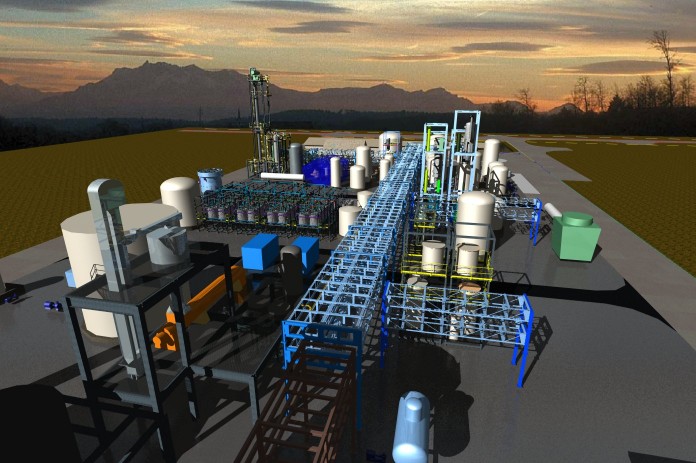Ethanol, our trash and our economy

This story has everything: suspense, victory, tragedy and a cliff-hanger. We still can't be sure how it's going to turn out. It all turns on Blue Fire, a California company aiming to build commercial-scale ethanol production plants, turning trash into sugars which can be fermented thence into ethanol.
I recently spoke with John Cuzens, CTO of Blue Fire, and he outlined the whole saga from molecule and ion to politics and placement of the plant. GETTING THE GRANT
In a competition that began with dozens of greentech companies, Blue Fire became one of six finalists to get approval and promise of some funding from the U.S. Department of Energy (DOE) to develop commercial-scale ethanol production. Money was set aside by the Energy Independence and Security Act of 2007, calling for the production of 100 million gallons per year (mgpy) of cellulosic biofuels by 2010. A longer term goal: 16 billion gallons by 2022. After six projects were chosen by DOE, Blue Fire moved ahead. It is now one of four winners still looking to build.
Here's where the economy comes in. The first proposed plant is next to the Lancaster landfill in southern California. Yet some opponents argued the plant would truck in trash from Los Angeles (not economically rational, of course) so that slowed down the permit process. By the end of 2008, Blue Fire had their permits...but not their private funding. Intervening months had cleared away local NIMBY objections, but it had also seen investors vanish. It is not certain that DOE will pony up all the cash needed so private investors are still being sought. HOW'S IT WORK: ECONOMICS
Cuzens gave me a far better explanation of their concentrated acid hydrolysis process than I can possibly relate. Blue Fire uses a process that includes 8 patents evenb though acid hydrolysis dates back to World War I when war-strapped European countries couldn't import sufficient petroleum. Until recently there wasn't much hope the process could be economically competitive.
Now Cuzens feels Blue Fire has enough improved technology and a modernized business plan that will make trash into ethanol a money-maker.
He points out that in much of southern California the green trash from lawn and garden and golf courses is already separately handled by landfill companies. In some cases, like the Lancaster landfill, Blue Fire will actually be paid to take this stuff, as much as $10-15 per ton. Blue Fire has looked at the tonnage of this green material in the six most populous counties in southern California. They see a potential for production of over 60-million gallons of ethanol per year. And any plant next door to a landfill doesn't have to buld a pick-up or delivery infrastructure. Blue Fire estimates they can produce 75 gallons of ethanol for every ton of dry biomass.
And large scale plants, 20-million gallons per year, or more, would not only be energy self-sufficient but could re-use both water and the concentrated sulphuric acid used in each cycle. Finally, Blue Fire sees placement of their plants as critical: near major population and traffic centers. Los Angeles certainly qualifies. It produces many tons of green waste, and it burns millions of gallons of auto fuel.
HOW'S IT WORK: CHEMICAL ENGINEERING 
Two of the remaining four biofuel producers in the DOE's select group are planning to use enzymatic bioreactors. Cuzens explained why Blue Fire sees acid hydrolysis as superior. Less need for energy: Blue Fire does not need either high temperatures nor high pressure to make their process work. That means the equipment used is less costly as well.
The uniformity of the biomass is less important because they do not need specific, appropriate enzymes. Often one will work for corn, not rice nor tree leaves. Sulphuric acid works equally well on all starches and the binding lignin found in plant matter.
Acid hydrolysis does require dry biomass. That green trash picked up by sanitation trucks often runs about 40% water, but once a commercial scale Blue Fire plant is running it will create enough hot air exhaust to be able to do its own drying essentially for free. The process would also allow complete reclaiming of steam by adding a condenser system at the exhaust end. This is particularly useful in dry areas like southern California.
Water use is a touchy issue among ethanol makers and critics. Cuzens told me their process requires about 5 gallons of water per gallon of ethanol. Then, much of that water could and should be reclaimed and re-used.
Blue Fire would use a continuous fermentation process on their sugars, producing ethanol in about six hours, much faster than many existing ethanol plants that can take up to three days. Anogther savings on storage and energy costs.
And, Cuzens points out, unlike ethanol from corn or sugar, the biomass Blue Fire wants to use green refuse has no other long-term human use. It could not be eaten, fed to livestock or turned into rum. It could truly be trash to cash. But the cash to build is what's missing right now.